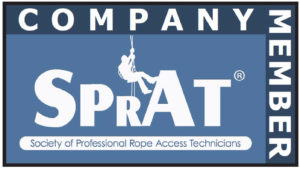Working at Height – Academy™ is a leading training provider in the head quartered in the County Clare in the Republic of Ireland, working across the European Union and also strategically we have a pacific side head quartered Houston, Texas, United States working across the Americas. Working at Height offers a wide range of training courses form; Industry Standard, Association Based & Bespoke Training.
SPRAT Level 1
Rope Access level 1 technician is capable of performing a limited range of rope access tasks
NOTE: This course is at User level – employers must ensure adequate supervision is provided for candidates following this course.
Entry level course covering a wide range of working locations. Recommended for candidates who wish to enter the industry as rope access subcontractors.
Characteristics of a safe system of work, including equipment, legal requirements, objective hazards, risk assessment and method statements, conformity and certification, inspection, emergency considerations and rescue procedures.
Basic principles of movement on ropes – ascent, descent, changing from ascent to descent, changing from rope to rope, crossing a knot, aid climbing and traversing, passing re-anchors and deviations, use of a back-up system, elementary rigging and rope management, elementary rescue.
Rope Access techniques can be used in a wide range of onshore and offshore activities i.e. to carry out theatre and concert rigging, maintenance and repair work, surveying and NDT (non-destructive testing), construction and groundwork’s, window cleaning and wind turbine blade cleaning etc.
It is advantageous if rope access technicians have an additional trade qualification to compliment their SPRAT qualification.
SPRAT Level 2
The Level 2 qualification is a stepping stone towards the SPRAT level 3 certificate.
Candidates must have 500 hours logged as a level 1 with a valid level 1 certificate
Intermediate level SPRAT certificate course for candidates who already have an SPRAT level 1 qualification and additional work experience.
An intermediate technician is capable of rigging working ropes, undertaking rescues and performing a variety of rope access tasks. They should have knowledge of legislation, safety requirements and quality assurance procedures relating to rope access.
SPRAT Level 3
Adequate supervision is essential for any rope access operation and employers should ensure that this is provided at every site.
The course is designed for candidates who work in a wide range of rope access situations and who have 500 hours logged under the SPRAT scheme.
Advanced course allowing supervision of a wide range of work sites. Candidates must possess an SPRAT level 2 certificate.
Theoretical content includes detailed knowledge of applicable legislation, competence in inspection and care of equipment, casualty care, risk assessment and method statements and site management requirements.
Practical skills covered include a full range of technical and/or complex access and rigging techniques, including fall protection methods, advanced rescue, lead climbing and application of pulley systems.
ISO Rope Access Level 1 (User)
This course is based broadly on the requirements of BS ISO 22846 for the purpose of undertaking rope access classified as “simple”. Ideal for companies who do not presently undertake rope access and wish to develop an in-house capability in specific, lower risk, environments. It allows a more detailed coverage of training skills in environments similar to the intended work environment.
NOTE: This course is at User level – employers must ensure adequate supervision is provided for candidates following this course
This entry level course is designed for those who have specific trade skills but wish to use rope access as a method of gaining access to their worksite.
The course is not intended for persons who will be working in varied work locations or who will be required to carry out a range of work tasks. Candidates wishing to work as general rope access sub-contractors should consider the SPRAT Level 1 course.
Covers the characteristics of a safe system of work, including equipment, legal requirements, objective hazards, risk assessment and method statements, conformity and certification, inspection, emergency considerations and rescue procedures.
The practical content includes the requirements of BS ISO 22846 the basic principles of movement on ropes – ascent, descent, changing from ascent to descent, changing from rope to rope, passing a deviation, use of a back-up system – elementary rigging and rope management, elementary rescue.
ISO Rope Access Level 2 (Supervisor)
A detailed course intended for candidates who already have experience of rope access but would like to move on to supervise sites of a specified type.
Advanced course for candidates who already have a rope access qualification and significant work experience.
This course is based broadly on the requirements of BS ISO 22846 for the purpose of undertaking rope access classified as “simple”
Course covers applicable legislation, competence in inspection and care of equipment, casualty care, risk assessments, method statements and site management requirements.
A full range of technical and/or complex access and rigging techniques are covered, including fall protection methods, advanced rescue techniques, lead climbing and pulley systems.

